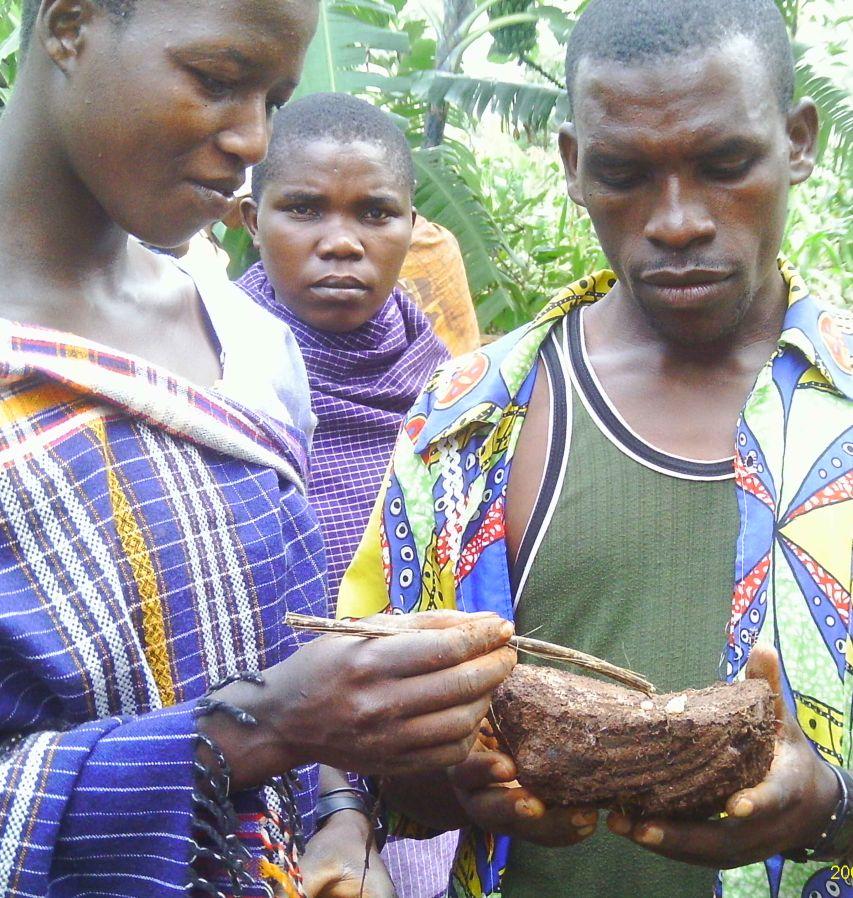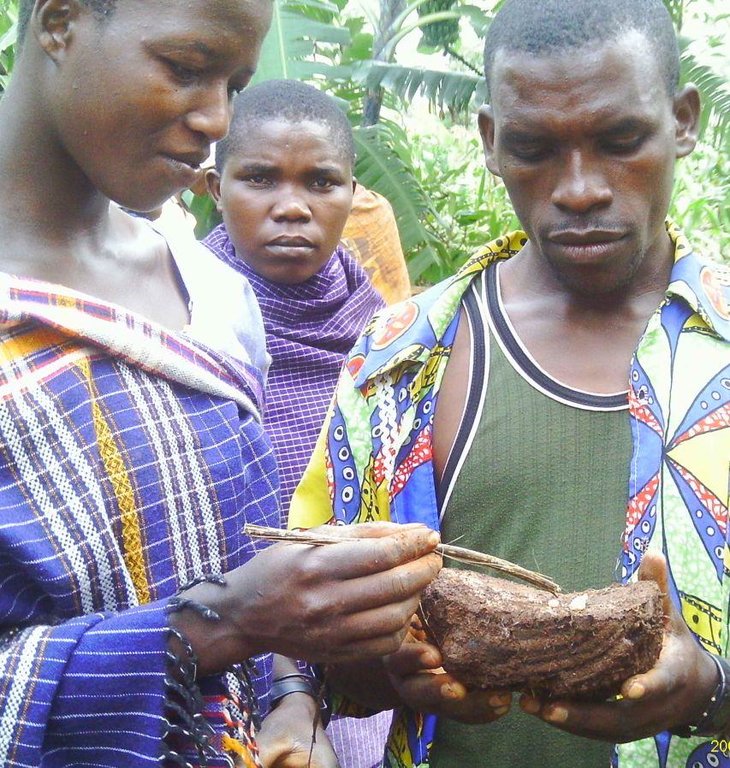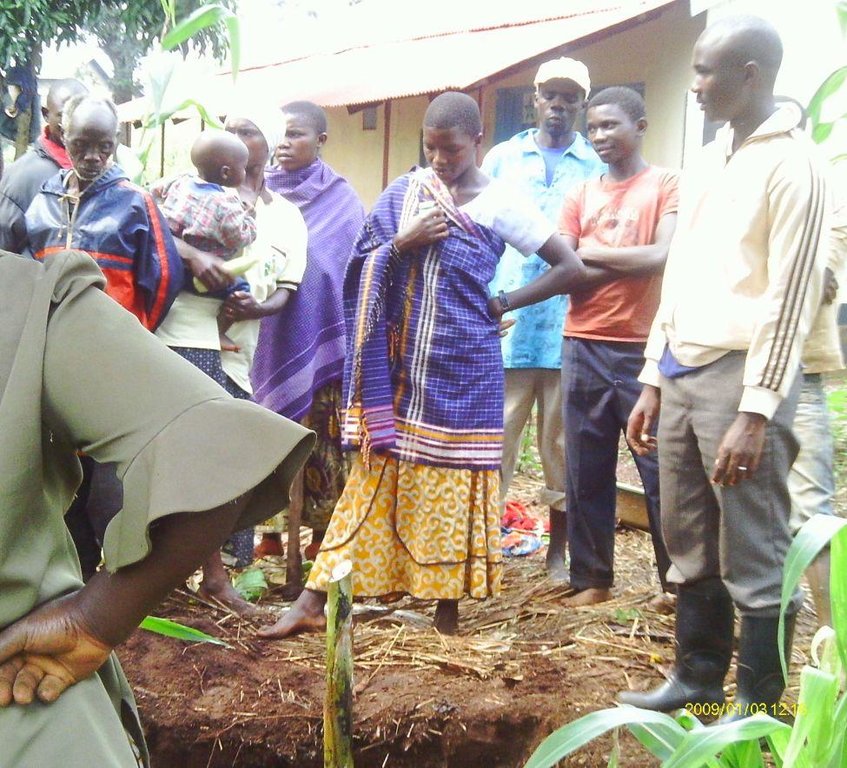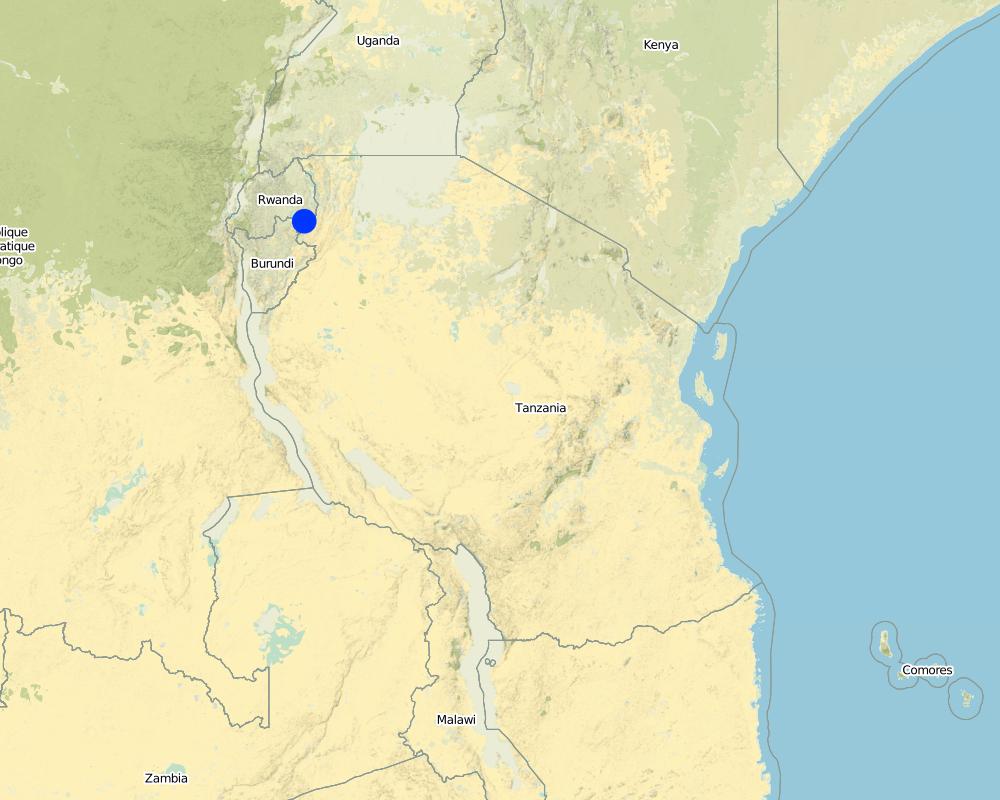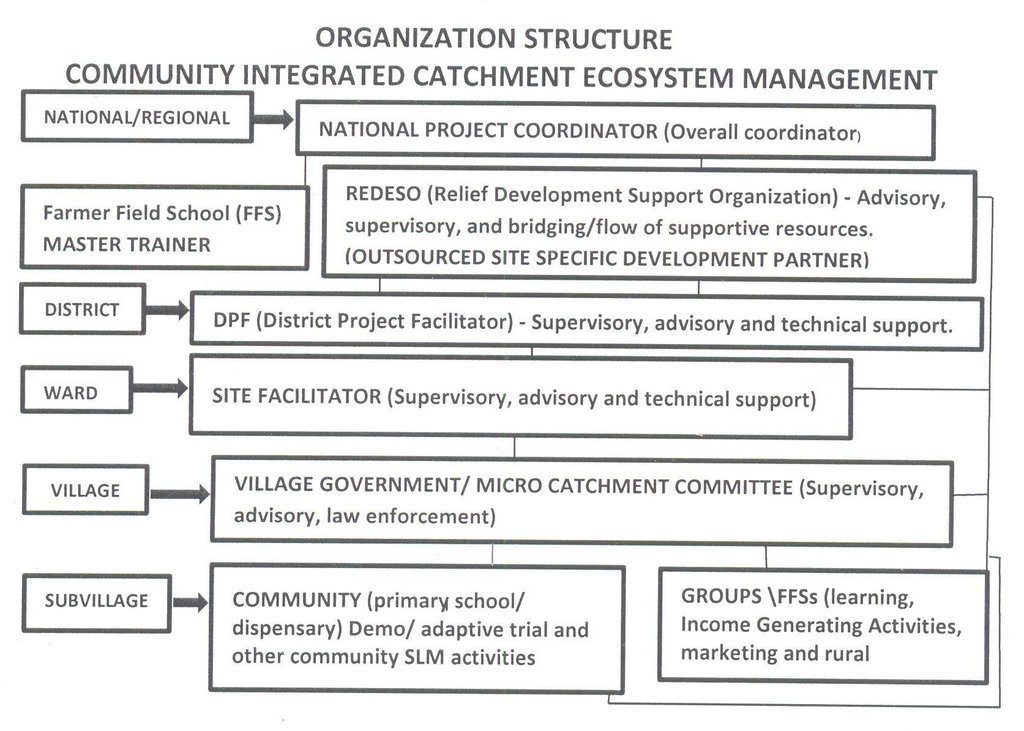Community intergrated catchment ecosystem management [坦桑尼亚联合共和国]
- 创建:
- 更新:
- 编制者: ALLAN BUBELWA
- 编辑者: –
- 审查者: Fabian Ottiger
Mfumo wa usimamizi wa ekolojia katika eneo bonde (Swahili)
approaches_2486 - 坦桑尼亚联合共和国
查看章节
全部展开 全部收起1. 一般信息
1.2 参与方法评估和文件编制的资源人员和机构的联系方式
SLM专业人员:
SLM专业人员:
SLM专业人员:
Mwasikundima Idephonce
Ngara District Council
坦桑尼亚联合共和国
有助于对方法进行记录/评估的机构名称(如相关)
Bukoba district council (Bukoba district council) - 坦桑尼亚联合共和国有助于对方法进行记录/评估的机构名称(如相关)
Ngara District Council (Ngara District Council) - 坦桑尼亚联合共和国1.3 关于使用通过WOCAT记录的数据的条件
(现场)数据是什么时候汇编的?:
10/03/2014
编制者和关键资源人员接受有关使用通过WOCAT记录数据的条件。:
是
1.4 SLM技术问卷的参考
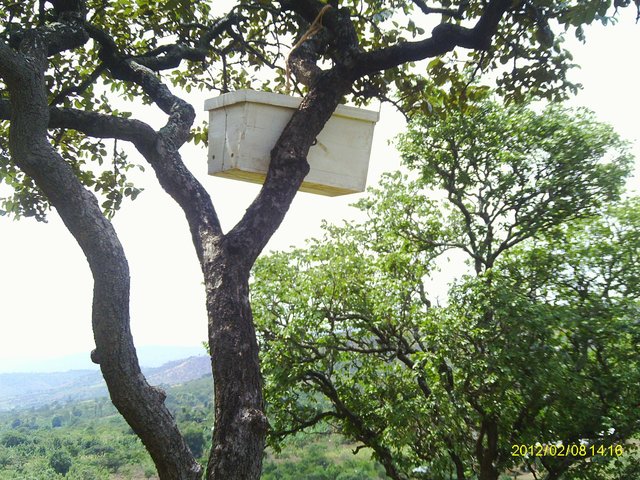
Natural forest conservation using apiaries [坦桑尼亚联合共和国]
Establishment of apiaries in natural forests to retard forest mismanagement and improve honey production
- 编制者: Philip Ileta
2. SLM方法的描述
2.1 该方法的简要说明
Adaptive Agro-ecosystem Micro-catchment Approach.
2.2 该方法的详细说明
该方法的详细说明:
Aims / objectives: SLM knowledge skill generation and capacity building. Improved group and community strength, sustainability, organization and their capacity to benefit and invest in SLM. Motivation of community participation in SLM through use of quick win project, income generating activities, rural micro finance institutions, marketing and active engagement of disadvantaged groups.
Methods: Wider promotion of basket of choice of SLM technologies through SLM Farmer Field School, Demonstration plots and community related activities. Make use and build on already existing and new groups, existing institutions and the community as a whole. Strategic use of easily available and accessible available community institutions/ infrastructures (school and dispensaries sites) to demonstrate and promote basket of choice of SLM technologies. Learning by doing on the job, practical training, adoption and adaptation to local reality.
Stages of implementation: Site characterization through land degradation analysis (LADA) and development of community site specific SLM plan exemplifying SLM interventions needed to address the identified degradation types. Set up and identification of approaches needed to execute identified interventions complementary approaches. Sensitization and awareness creation to the community and actual execution of approaches.
Role of stakeholders: Individual groups: are core implementers and potential beneficiaries of the project.
Extension worker: Advisory and technical backstopping.
Elected and employed leaders at the sub-village, village and ward level: bylaw/law enforcement, supervisory and land provision.
Relief for Development Societies NGO (REDESO): Service provision and development partner in SLM.
Trans boundary Agro-ecosystem Management Project (TAMP): Provision of supportive resources (financial and technical).
Ngara district council: Supervisory, technical, policy interpretation, monitoring and evaluation, documentation, analysis and shairing .
Rugenge/Kirusha Micro catchment Committee: Supervisory, advisory and law enforcement.
2.3 该方法的照片
2.5 采用该方法的国家/地区/地点
国家:
坦桑尼亚联合共和国
区域/州/省:
Tanzania
有关地点的进一步说明:
Ngara
Map
×2.6 该方法的开始和终止日期
注明开始年份:
2010
终止年份(若不再采用该方法):
2014
2.7 方法的类型
- 基于项目/方案
2.8 该方法的主要目的/目标
The Approach focused mainly on SLM with other activities (Motivating quick win income generation activities, rural microfinance institutions, marketing and HIV/AIDS controll.)
Knowledge/skill generation, demonstration and sustainability of SLM activities.
Motivate active participation of the community.
Inculcate a sense of community ownership/ community take charge of SLM activities.
The SLM Approach addressed the following problems: Lack of technical knowledge
Low investment capacity
Malpractice and mismanagement of local resources (e.g. fire burning, ploughing along the slope).
Adequate supervision, monitoring and law enforcement.
2.9 推动或妨碍实施本办法所适用的技术的条件
社会/文化/宗教规范和价值观
- 阻碍
Negative cultural believes that fire burning can lead to one living long or reach older age.
Treatment through the SLM Approach: Change of mind set through FFS training, demos and community sensitization.
财务资源和服务的可用性/可得性
- 阻碍
Low investment capacity and inability to access supportive resources
Treatment through the SLM Approach: Easy access to TAMP supportive resources.
机构设置
- 阻碍
Narrow coverage of the district, local institutions not involved in in SLM.
Treatment through the SLM Approach: Higher coverage, ope-rationalization of SLM in LGA system.
法律框架(土地使用权、土地和水使用权)
- 启动
The existing land ownership, land use rights / water rights helped a little the approach implementation: Hindrance is usually observant for approaches which need long term commitment of land resources (e.g perennial crops) but is minimal for short term (annuals and biannual).
Open access land resources are difficult to manage.
- 阻碍
Reluctance of the village to issue land, less protection of open access land resources.
Treatment through the SLM Approach: land issuing for FFS/Demo use legally recognized through signing of Memorandum Of Understanding (MOU) between the village and land users/SLM groups. Bylaws reinforcement to protect mismanagement of open access land resources.
了解SLM,获得技术支持
- 阻碍
Inadequate understanding and use of SLM technical knowledge (both scientific and indigenous) to address land degradation problems.
Treatment through the SLM Approach: Up scaling use of scientific SLM knowledge.
Documentation, evaluation, analysis and sharing of successful indigenous SLM technical knowledge.
工作量、人力资源可用性
- 阻碍
High workload to extension officers (due to their shortage).
Treatment through the SLM Approach: Build a local resource base in facilitating SLM activities through introduction of community SLM facilitators and Micro-catchment committee.
其他
- 阻碍
Low motivation due to long term realization of SLM benefits.
Treatment through the SLM Approach: introduce SLM related quick win projects and income generation activities (IGA).
3. 相关利益相关者的参与和角色
3.1 该方法涉及的利益相关者及其职责
- 当地土地使用者/当地社区
Core implementors. all gender, youth and elders . Widows, Orphans, People living with HIV/AIDS were actively indiscriminately involved in FFS, Demos and community related activities..
- SLM专家/农业顾问
all gender, youth and elders
- 教师/学龄儿童/学生
all gender, youth and elders
- NGO
dvisory, technical back stopping, supervisory and monitoring.
- 地方政府
Advisory, technical back stopping, supervisory and monitoring.
- 国家政府(规划者、决策者)
dvisory, technical back stopping, supervisory and monitoring.
- 国际组织
dvisory, supervisory and monitoring.
如果涉及多个利益相关者,请注明领导机构:
Land user (all genders, youth and elders): consulted and made informed decision about the approach to be used. National specialists: potential facilitators in designing and community sensitization. International specialists: consultative and subject matter specialist (e.g. FFS specialist)
3.2 当地土地使用者/当地社区参与该方法的不同阶段
| 当地土地使用者/当地社区的参与 | 指定参与人员并描述活动 | |
|---|---|---|
| 启动/动机 | 被动 | Community, groups, employed and elected leaders: participated in sensitization and awareness creation process. |
| 计划 | 互动 | Community, groups, employed and elected leaders: active participants and decision makers in planning e.g. selection of FFS community facilitators and formation of micro-catchment committee. |
| 实施 | 外部支持 | Community, groups, employed and elected leaders: core and key implementers of the approach. |
| 监测/评估 | 互动 | Community, groups, employed and elected leaders: self mobilized and client interactive monitoring. |
| Research | 互动 | Community, groups, employed and elected leaders: site identification and active implementers of adaptive trials (e.g use of fanya juu/chini terraces, vertivar grass e.t.c). Adopters, users and promoters of the best bets technologies. |
3.3 流程图(如可用)
具体说明:
organization structure of community integrated catchment ecosystem management.
作者:
Allan Isaka Bubelwa (Box 38 Kyaka Missenyi Kagera Tanzania)
3.4 有关SLM技术选择的决策
具体说明谁有权决定选择要实施的技术:
- 主要是土地使用者,由SLM专家提供支持
解释:
Land users working in collaboration with SLM specialist through a participatory dialogue and decision making process.
Decisions on the method of implementing the SLM Technology were made by mainly by land users supported by SLM specialists. During inception of the project, land users were actively involved in deciding on the type of method to adopt e.g. selection of site and test crops for FFS, Demo and community related SLM activities.
4. 技术支持、能力建设和知识管理
4.1 能力建设/培训
是否为土地使用者/其他利益相关者提供培训?:
是
明确受训人员:
- 土地使用者
- 现场工作人员/顾问
- employed and elected leaders
如果相关,请说明性别、年龄、地位、种族等。:
Both gender, all age (youth and elders)
培训形式:
- 在职
- 农民对农民
- 示范区域
涵盖的主题:
SLM related subjects
4.2 咨询服务
土地使用者有权使用咨询服务吗?:
是
指明是否提供了咨询服务:
- 在土地使用者的土地上
说明/注释:
Name of method used for advisory service: Farmer field schools (FFS); Key elements: Practical training and learning by doing., Basket of choice of Technologies/Demos., Group oriented and site specific; Adoption depends on farmers choice and ability to invest.
Advisory service is inadequate to ensure the continuation of land conservation activities; There is limited knowledge and low funding capacity.
4.3 机构强化(组织发展)
是否通过这种方法建立或加强了机构?:
- 是,适度
具体说明机构的强化或建立程度:
- 本地
具体说明支持类型:
- 能力建设/培训
提供进一步细节:
Training provision to micro-catchment committee.
4.4 监测和评估
监测和评估是该方法的一部分吗?:
是
注释:
bio-physical aspects were ad hoc monitored by project staff, government, land users through observations; indicators: hactarage conserved
bio-physical aspects were ad hoc monitored by project staff, government, land users through measurements; indicators: hactarage conserved
technical aspects were regular monitored by project staff, government, land users through observations; indicators: number of adopters
technical aspects were regular monitored by project staff, government, land users through measurements; indicators: number of adopters
socio-cultural aspects were regular monitored by project staff, government, land users through observations; indicators: % involvement of women
socio-cultural aspects were regular monitored by project staff, government, land users through measurements; indicators: % involvement of women
economic / production aspects were regular monitored by project staff, government, land users through observations; indicators: % increase in yield and income
economic / production aspects were regular monitored by project staff, government, land users through measurements; indicators: % increase in yield and income
area treated aspects were regular monitored by project staff, government, land users through observations; indicators: hactarage conserved
area treated aspects were regular monitored by project staff, government, land users through measurements; indicators: hactarage conserved
no. of land users involved aspects were regular monitored by project staff, government, land users through observations; indicators: number of adopters
no. of land users involved aspects were regular monitored by project staff, government, land users through measurements; indicators: number of adopters
management of Approach aspects were regular monitored by project staff, government, land users through observations; indicators: Number of FFS, Demos and IGA
management of Approach aspects were monitored through measurements; indicators: umber of FFS, Demos and IGA
There were several changes in the Approach as a result of monitoring and evaluation: Introduction of FFS farmer facilitators and Micro-catchment committees.
There were few changes in the Technology as a result of monitoring and evaluation: In the course of implementation adjusting or modifying technologies to suit agro-ecological condition or landforms
4.5 研究
研究是该方法的一部分吗?
是
- adaptive SLM trials
提供进一步的细节,并指出是谁做的研究:
Adaptive SLM trials run by community/district/ARI Maruku through demos where farmers can select the best bets to apply and try on their own fields.
Research was carried out on-farm
5. 融资和外部物质支持
5.1 该方法中SLM组成部分的年度预算
如果不知道准确的年度预算,请给出一个范围:
- 10,000-100,000
注释(例如主要的资助来源/主要捐助者):
Approach costs were met by the following donors: international (TAMP): 50.0%; government (Region/ARI Maruku.): 10.0%; local government (district, county, municipality, village etc) (Ngara district council, Villages and Ward): 20.0%; local community / land user(s) (Local community and groups withi the microcatchment ): 20.0%
5.2 为土地使用者提供财政/物质支援
土地使用者是否获得实施该技术的财政/物质支持?:
是
5.3 对特定投入的补贴(包括劳动力)
- 设备
| 具体说明哪些投入得到了补贴 | 程度如何 | 对补贴做出具体说明 |
|---|---|---|
| 工具 | 充分融资 | Working gears (gun boots, raincoats, T-shirts) |
| Computers, cameras | 充分融资 | |
- 农业
| 具体说明哪些投入得到了补贴 | 程度如何 | 对补贴做出具体说明 |
|---|---|---|
| 种子 | 部分融资 | |
| 化肥 | 部分融资 | |
| Manure | 部分融资 | |
- 其它
| 其它(具体说明) | 程度如何 | 对补贴做出具体说明 |
|---|---|---|
| Livestock | 充分融资 | Chicken, goats and bees |
如果土地使用者的劳动力是一项重要的投入,那么是不是:
- 自愿
注释:
labour was largely voluntarily and was rewarded indirectly by introduction of income generating activities.
Some inputs were fully financed, partly financed and not financed. Materials fully financed are those not available at the site or not adequately available or in shortage.
5.4 信用
是否根据SLM活动的方法给予信用值?:
否
6. 影响分析和结论性陈述
6.1 方法的影响
该方法是否帮助土地使用者实施和维护SLM技术?:
- 否
- 是,很少
- 是,中等
- 是,支持力度很大
Knowledge and skill acquired through FFS, Demos and community related intervention played significant role in improvement of SLM. Bylaw reinforcement significantly prevented malpractices/land resource mismanagement.
该方法是否有助于社会和经济弱势群体?:
- 否
- 是,很少
- 是,中等
- 是,支持力度很大
Improved to livelihood mechanism/alternates to widow, orphan and people living with HIV/AIDS
该方法是否改善了阻碍SLM技术实施的土地使用权/用户权问题?:
- 否
- 是,很少
- 是,中等
- 是,支持力度很大
The approach involve signing of memorandum of understanding (MOU) over use of land resource between farmer groups running Demos and FFS and the village government. MOU is a strong and reliable legal acquisition of land resource to be used for conservation activities.
Did other land users / projects adopt the Approach?
- 否
- 是,很少
- 是,中等
- 是,支持力度很大
On average each FFS member induced adoption to 2 household farmers.
Did the Approach lead to improved livelihoods / human well-being?
- 否
- 是,很少
- 是,中等
- 是,支持力度很大
Diversification of income sources through introduction of Quick win income generating (IGA) AND
Did the Approach help to alleviate poverty?
- 否
- 是,很少
- 是,中等
- 是,支持力度很大
Improvement of livelihood alternates and income, the situation is improve in the future.
6.2 土地使用者实施SLM的主要动机
- 增加生产
increased production to meet daily needs and surplus for selling.
- 增加利润(能力),提高成本效益比
increased surplus and income accrued through surplus generation.
- well-being and livelihoods improvement
food security and income is the first priority.
6.3 方法活动的可持续性
土地使用者能否维持通过该方法实施的措施(无外部支持的情况下)?:
- 是
若是,请说明如何维持:
Farmers have realized the benefit of SLM. The village historical track records and experience indicate that farmers in Kirusha village usually continue what ever they come to realize is implemented for their own benefit. Further more, establishment of local human resource in SLM in terms of FFS facilitators and micro-catchment committee and their ope-rationalization into LGA systems is an assure way towards sustainability.
Motivation induced through quick win income generating activities (goat production, chicken, piggery, fruit tree nurseries and apiaries) and easy to manage demo set at Kirushya primary school and dispensary (reachable and easily accessible) are added assurance for project sustainability.
6.4 该方法的长处/优点
| 土地使用者眼中的长处/优势/机会 |
|---|
| Learning and acquisition of knowledge (How to sustain/ enhance this strength: continuation of FFS, Demo and community activities.) |
| Cohesiveness and self help (How to sustain/ enhance this strength: Continue promotion of VICOBA and Market. ) |
| Spread of knowledge within and outside village. (How to sustain/ enhance this strength: Continue use of the approach. ) |
| 编制者或其他关键资源人员认为的长处/优势/机会 |
|---|
| Improved relationship, unity, cohesiveness and common voice. (How to sustain/ enhance this strength: Continue with promotion, strengthening and establishment of IGA, SACCAS and VICOBA.) |
| More farmers are involved (rapid adoption and expansion) (How to sustain/ enhance this strength: Up scaling and strengthening of FFS, Demos, and IGA. ) |
| The approach is cost effective (benefit surpass costs) (How to sustain/ enhance this strength: Promote, expand and continue use of FFS, Demos and IGA.) |
| Assured and promising elements of sustainability. (How to sustain/ enhance this strength: Strengthen ope-rationalization and use of micro-catchment committee and FFS facilitators. ) |
|
Easy access to supportive resources (Land and financial) (How to sustain/ enhance this strength: strengthen and liaise FFS with service providers (Bank, SACCOS and Marketing)) |
6.5 该方法的弱点/缺点以及克服它们的方法
| 土地使用者认为的弱点/缺点/风险 | 如何克服它们? |
|---|---|
|
Negative customs and believes (it is believed that one can live longer and reach older age by setting fire and burning of a large area). |
Discourage negative custom and believes |
| Reluctance of household heads especially in patrimonial societies. | Community sensitization to gender (gender be addressed as the basic component of the approach). |
| Failure and negative experience of past development projects and programmes. | Change of mind set |
| Shortage of inputs and working facilities | Promote availability and accessibility of inputs and working facilities. |
| 编制者或其他关键资源人员认为的弱点/缺点/风险 | 如何克服它们? |
|---|---|
| Selfishness, individualism by some untrustworthy politicians and leaders. | Combine SLM promotion with civic education training. |
| Prone to natural calamities and disastrous events | Introduce and strengthen use of Agro-based insurance. |
| Largely relies on government or farmer willingness to release and offer land. | Sensitize and encourage use of MOU. |
| If not done in precaution can perpetuate dependency syndrome | Encourage use of self mobilized farmer groups and their strengthening and ope-rationalization into existing systems. |
| Reliable external supportive resource needed initially | Reliable and timely supply of supportive resources. |
7. 参考和链接
7.1 方法/信息来源
- 实地考察、实地调查
- 与土地使用者的访谈
7.2 参考可用出版物
标题、作者、年份、ISBN:
Site characterization report: Kimamba Lyoba,
链接和模块
全部展开 全部收起链接

Natural forest conservation using apiaries [坦桑尼亚联合共和国]
Establishment of apiaries in natural forests to retard forest mismanagement and improve honey production
- 编制者: Philip Ileta
模块
无模块


